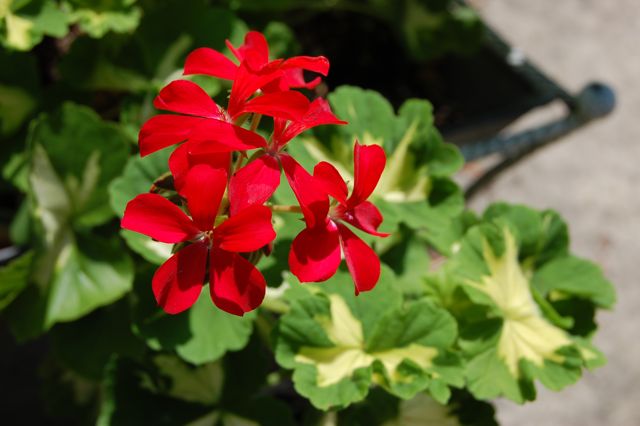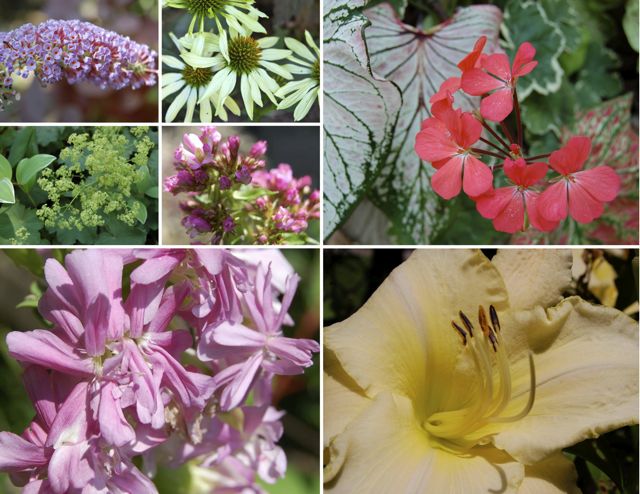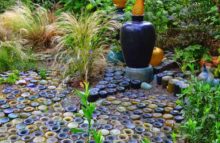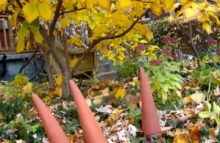Sarah and I garden two doors away from each other in the same dry shady conditions. But, when it comes to colour, we couldn’t be further apart. Sarah’s all about the hot colours, reds, oranges, yellows; I prefer mine muted, going for pinks, corals, creams and blues.
The red of this little ‘Happy Thought’ pelargonium – which has overtones of both orange and pink – is perhaps the perfect cross-over point. I grow it in one of my sunnier spots, because I like to have happy thoughts in the garden.
Why limit your colour palette in shade? Hot colours can really turn on the lights, as you can see by this collage from Sarah’s garden. It features butterfly weed (Asclepias tuberosa), a marmaladey Gaillardia, Sarah’s signature orangey red impatiens paired with chartreuse ‘Marguerite’ sweet potato vine (Ipomeoa batatas), yellow Crocosmia, red daylilies (Hemerocallis), and a shot of brightness from remarkably shade-tolerant Shasta daisies (Leucanthemum x superbum). Not shown is Sarah’s great collection of red and orange pelargoniums.
As hot colours visually advance (cool colours recede) in a garden, they’re often avoided in small spaces, as they’re thought to make a garden feel smaller. Shade, however, tones down this effect. And in gardens as small as ours, why not just go for the golds!
These flowers may all be a little less flowery in shady conditions – despite being under Norway maples, Sarah’s shade is somewhat dappled – but they do add welcome warmth.
I, on the other hand, try to make the garden feel as expansive as possible using pastels, stronger in intensity here and there.
My collage includes a salmon pelargonium with ferns and Caladium in the front planter. Around the garden right now, there’s Hemerocallis ‘Gentle Shepherd’, the double Saponaria aka soapwort or Bouncing Bet that came with the garden, the chartreuse flowers of lady’s mantle (Alchemilla mollis), a purple butterfly bush (Buddleia davidii), a creamy Echinacea ‘Sunrise’, and the odd-looking flowers of a Phlox in the ‘Feelings’ series.
I’m particularly fond of the creams within this colour key, picked up by the foliage variegation in my hosta collection. You’ll notice that chartreuse shows up in both palettes; it’s a hot yellow-green that works in sun or shade.
There you go. Two colour strategies for shade. What works for you?
To look at colours in other gardens worldwide, head over to May Dreams Gardens, where on the 15th of each month blogger extraordinaire Carol invites us to share Garden Blogger’s Bloom Day.







7 comments
Helen, I love the shade of yellow of the daylilly. I'm all about the daylillys lately. The ones at the nursery are all in flower so I can be sure to get the colours I want.
I'm with both of you, chartreuse is the perfect color for shade gardens. White is too strident & distracting, and chartreuse seems the perfect harmonizer. Instead of hot or pastel, I go for bright colors, fuschia, magenta, hot pink, purple, ruby in the shade. I just don't like orange.
I grow on sandy soil in full sun mostly but I love hot colours in the heat. In what shade I have I grow more muted colours. Both combinations work for me. Great mosiacs of your lovely bloom.s
In the shade I'm all about the creams & greens contrasting. Purples & blue's are more my shade preference. Although I see the merit in both strategies. Gorgeous blooms ladies!
My strategy is to grow what ever will grow in dry shade in the heat and humidity of a southern summer! I do lean toward native plants, since the conditions here can be extreme. I can grow with success only one or two named hostas~Gaucamole is one I can recommend. It leans toward chartreuse and flowered for the first time this year~it's fragrant. Rudbeckias, phlox and purple coneflower seem to handle shade…gail
This was a great post about two very different gardening styles and why they both work. Loved meeting you both in Buffalo.~~Dee
I don't have much dry shade, but I generally do stay away from "hot" colors in the garden. Interesting approaches, though, to the same conditions!